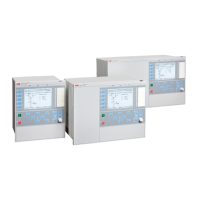11.6.3 Two step residual overvoltage protection ROV2PTOV (59N)
Prepare the IED for verification of settings outlined in Section
"Preparing the IED to
verify settings".
11.6.3.1 Verifying the settings
1. Apply a single-phase voltage either to a single-phase voltage input or to a residual
voltage input with the pickup value below the set value Pickup1.
2. Slowly increase the value until PU_ST1 appears.
3. Note the trip value and compare it with the set value.
4. Decrease the voltage slowly and note the reset value.
5. Set and apply a 20% higher voltage than the measured trip value for one phase.
6. Measure the time delay for the TRST1 signal and compare it with the set value.
7. Check the inverse time delay by injecting a voltage corresponding to 1.2 ×
Vpickup>.
For example, if the inverse time curve A is selected, the trip signals
TRST1 and TRIP trip after a time corresponding to the equation:
IECEQUATION2429 V1 EN (Equation 101)
( )
1
1
TD
t s
V
Vpickup
=
æ ö
-
ç ÷
>
è ø
ANSIEQUATION2429 V1 EN (Equation 102)
where:
t(s) Trip time in seconds
TD1 Settable time multiplier of the function for step 1
V Measured voltage
Vpickup> Set pickup voltage for step 1
For example, if the measured voltage jumps from 0 to 1.2 times the set pickup
voltage level and time multiplier TD1 is set to 0.05 s (default value), then the TRST1
and TRIP signals trip at a time equal to 0.250 s ± tolerance.
8. Repeat the test for Step 2 of the function.
1MRK 504 165-UUS - Section 11
Testing functionality by secondary injection
Transformer protection RET670 2.2 ANSI 215
Commissioning manual

